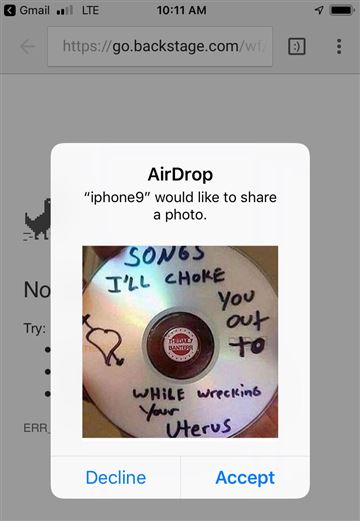 2991
2991
 2018-11-26
2018-11-26

Abigail Mentzer was riding the New York City subway to a doctor’s appointment when she says an AirDrop request popped up on her iPhone. A preview image of the file showed a CD with the handwritten message, “Songs I’ll choke you out to while wrecking your uterus.”

Feeling disgusted and threatened, she looked around the train car, wondering who had sent it. Then, three more messages came through, including images of a woman’s bare behind and more offensive language.
“I had never gotten an AirDrop from a random person before. I didn’t know this could happen,” Mentzer, 35, an actress and dancer, told NBC News recently. “I guess it makes sense in this day and age, to find new, inventive ways to harass people.”
AirDrop is an iPhone feature that allows users to share photos and other files quickly, without disclosing their phone number or email address. The message arrives from the name of the iPhone (Mentzer’s message came from “iPhone 9”), giving the sender anonymity. Users need to be within roughly 30 feet of each other to send an AirDrop, which operates over Bluetooth and Wi-Fi.
Crowded spaces are fertile ground for AirDrop harassers. Public transport in particular seems to be a danger zone. The New York subway system has been the scene of several disturbing incidents, and a reporter for HuffPost UK reportedly received over 100 lewd AirDrops while riding the London Tube.
The British Transport Police, who monitor the nation's railways and the London Underground, said they receive two to three reports about "cyberflashing" via AirDrop a month.
“As with other forms of sexual harassment, we believe that cases of cyberflashing, which can involve the sending of unwanted, threatening or explicit sexual communications, goes largely unreported — either because victims don’t feel the incident is serious enough to report or simply because they don’t know where to turn,” Detective Inspector Ashley Cooper said in an email.
Saving an offensive AirDrop image can help the police with their investigation, said Nikki Nagler, a spokeswoman for the British Transport Police. If a suspect is identified and arrested, images on his phone can be compared with the offensive image on the victim's phone. "As you can imagine, identifying suspects with sexually explicit photos can be challenging," she said in an email.
She added that it is "completely understandable" that victims will not want to store unwanted sexual images on their phones, and can provide police with a copy in that case.
Default settings on the iPhone are set to accept AirDrops from contacts only. But because the purpose of AirDrop is to quickly share files without exchanging contact information, many iPhone owners change the setting to “everyone.”
Navigating the settings can be confusing, and there’s no warning on the iPhone about the implications of setting AirDrop to “everyone.”
A spokeswoman for Apple declined to comment on the phenomenon of viewing unwanted messages. She said users can keep the settings on “contacts only,” or turn off Bluetooth and Wi-Fi.
Source: nbc news